Physical Address
304 North Cardinal St.
Dorchester Center, MA 02124
Point-of-care ultrasound performed in the critical care setting is a valuable tool for augmenting traditional methods of clinical evaluation.
Key components of this examination include portable ultrasound imaging with “real-time” interpretation at the bedside in a focused, reproducible, goal-directed, and rapid fashion to answer specific clinical questions and guide subsequent clinical intervention.
In the intensive care unit, airway ultrasound can assess the difficult airway, guide the performance of procedures such as cricothyroidotomy and tracheostomy, confirm endotracheal tube placement, and facilitate regional blocks to aid in airway management.
Lung ultrasound can identify the major disease patterns in the lung and pleural space, as well as assess diaphragmatic function.
Focused transthoracic echocardiography can diagnose cardiac pathologies, trend subsequent responses to treatment interventions, and confirm appropriate positioning of circulatory assist devices.
Gastric ultrasound allows rapid assessment of gastric contents to guide airway management and to minimize aspiration risk.
The Focused Assessment with Sonography in Trauma examination is a valuable tool for identifying abdominal and pelvic pathology with high specificity and relatively low sensitivity.
Vascular ultrasound can guide vascular access, predict volume responsiveness, and diagnose lower extremity deep venous thrombosis. The venous excess ultrasound scanning approach can also evaluate volume overload and systemic venous congestion.
Point-of-care ultrasound (POCUS) utilizes portable ultrasound imaging at the bedside with interpretation in “real time.” The examination is focused, reproducible, goal-directed, and quickly performed to answer clinical questions, narrow the differential diagnosis, and guide clinical interventions. , POCUS may be synonymous with critical care ultrasound and the goals remain the same. The growth of POCUS has been accelerated by the progress in mobile handheld devices as well as the COVID-19 pandemic with the emphasis on bedside diagnosis to minimize cross-infection. This chapter will describe the POCUS applications across multiple organ systems ( Table 32.1 , Box 32.1 ) with an ABC approach (A: airway, B: breathing, and C: circulation) to augment the physical examination.
| Assessment | Structures | Utility |
|---|---|---|
| Airway | Cricothyroid membrane, tracheal rings | Airway management, cricothyroidotomy, tracheostomy |
| Breathing | Pleura and lung Diaphragm |
Pneumothorax, pleural effusion, parenchymal disease, pulmonary edema Diaphragmatic paresis, weaning of mechanical ventilation |
| Circulation (cardiac) | LV, RV, valves Pericardium Thoracic aorta |
Myocardial ischemia, CHF, valvular lesions Tamponade, effusion Aortic aneurysm and dissection |
| Abdomen (FAST) | Morrison’s pouch Splenorenal pouch Pelvis |
Liver laceration, blunt trauma Splenic laceration, blunt trauma Pelvic collection, bladder assay |
| Gastric | Antrum | Gastric volume and contents |
| Vascular | Veins Arteries |
Central and peripheral venous cannulation Invasive monitoring, IABP |
| IVC VExUS scan |
Volume status Fluid overload |
|
| Deep veins | DVT |
Airway ultrasound
Lung and diaphragm ultrasound
Cardiac ultrasound (transthoracic echocardiography)
Gastric ultrasound
Focused Assessment with Sonography in Trauma
Vascular ultrasound
Venous excess ultrasound scan
Many societies have developed training pathways to achieve competence in POCUS, including the American Society of Anesthesiologists, the National Board of Echocardiography, the Society for Critical Care Medicine, and the American Society of Regional Anesthesia. Furthermore, POCUS is in the core curriculum for anesthesiology residency training and is now included in the American Board of Anesthesiology certification process.
Upper airway structures can be comprehensively assessed by POCUS. A thorough understanding of airway sonoanatomy can serve as an imaging platform to access the airway, facilitate regional airway blocks, and confirm endotracheal tube position. The important airway structures include the tongue, hyoid bone, epiglottis, thyrohyoid membrane, thyroid cartilage, cricothyroid membrane, cricoid cartilage, trachea, and esophagus ( Tables 32.2 and 32.3 , Figs. 32.1–32.10 , Box 32.2 ). The scanning technique divides upper airway structures into suprahyoid and infrahyoid areas. A high-frequency, linear transducer probe (13–16 MHz) is adequate to scan infrahyoid structures, while a low-frequency, curved transducer probe (3–8 MHz) is more suitable for the deeper suprahyoid structures. The patient should be supine, with the head extended as needed to optimize visualization.
| Anatomical Structure | Probe Position and Image Acquisition | Sonographic Appearance |
|---|---|---|
| Tongue | Midsagittal, below the mentum | Fan shaped with intrinsic muscles giving striated appearance. Hyperechoic line of dorsal surface from (A-M) air-mucosal interface ( Fig. 32.2 ) |
| Hyoid bone | Transverse over the neck, slide caudad from the mentum | Superficial hyperechoic inverted U-shaped linear structure ( Fig. 32.3 ) |
| Sagittal or parasagittal | Narrow curved structure, casting acoustic shadow ( Fig. 32.2 ) | |
| Epiglottis | Transverse above the thyroid cartilage through the thyrohyoid membrane window | Hypoechoic transverse curvilinear structure, with hyperechoic preepiglottic space and bright A-M interface delineating the posterior border ( Fig. 32.4 ) |
| Sagittal in most subjects | Hypoechoic longitudinal curvilinear structure | |
| Thyrohyoid membrane | Transverse between the hyoid bone and the thyroid cartilage | Hyperechoic line between the hyoid bone and thyroid cartilage |
| Parasagittal | Hyperechoic line between the hyoid bone and thyroid cartilage ( Fig. 32.5 ) | |
| Thyroid cartilage | Transverse on thyroid prominence | Inverted V-shaped hypoechoic, with varying age-related hyperechogenicity and intraglottic structures ( Fig. 32.6 ) |
| Parasagittal over the thyroid cartilage | Linear hypoechoic structure with varying calcification ( Fig. 32.5 ) | |
| Cricothyroid membrane | Transverse using TACA technique | Hyperechoic transverse line between the thyroid and cricoid cartilages ( Fig. 32.7 ) |
| Midsagittal probe above the suprasternal notch and slide cephalad | Longitudinal hyperechoic line between thyroid and cricoid cartilages ( Fig. 32.10 ) | |
| Cricoid cartilage | Transverse over the cricoid cartilage | Superficial thick hypoechoic arch-shaped structure ( Fig. 32.8 ) |
| Sagittal, probe above the suprasternal notch | Hypoechoic oval structure larger than the tracheal rings ( Fig. 32.10 ) | |
| Trachea | Transverse over the suprasternal notch | Inverted U-shaped hypoechoic rings on transverse view ( Fig. 32.9 ) |
| Midsagittal over the suprasternal notch | Hypoechoic oval structures (string of pearls/beads appearance) ( Fig. 32.10 ) | |
| Esophagus | Transverse over the suprasternal notch sliding laterally (usually to left) | Collapsed muscular structure lateral to trachea. Swallowing facilitates its identification |
| I (Indication) | A (Acquisition of Image ) | I (Image Interpretation) | M (Medical Decision-Making) |
|---|---|---|---|
| Tracheostomy | Transverse scan sliding from thyroid cartilage to cricoid cartilage and down to tracheal rings. Midsagittal scan above suprasternal notch locating the tracheal rings, cricoid, and thyroid cartilages with hyperechoic CTM in between. | Locating and counting the tracheal rings | Determine the best space between the tracheal rings, avoiding blood vessels and thyroid isthmus for tracheostomy |
| Cricothyrotomy for elective/emergency airway access Cricothyroid puncture for transtracheal topical anesthesia |
Transverse scan sliding from thyroid cartilage to cricoid cartilage and back to CTM (TACA technique). Midsagittal scan over the thyroid and cricoid cartilages with hyperechoic CTM in between. | Locating the level, midpoint, and size of the CTM | Determine safe and correct entry point for emergency airway access |
| Determine safe and correct entry point for topicalization | |||
| Confirmation of endotracheal intubation Rule out esophageal intubation |
Transverse scan over the glottis and/or the trachea at suprasternal notch Scan both sides of chest for bilateral lung sliding |
Movement of glottic structures as tube passes. “Bullet sign” (Fig. 32.13) for tracheal and “double tract” sign for esophageal intubation (Fig. 32.14) | Determine the safety and use of the ETT for ventilation Reintubate if esophageal |
| Superior laryngeal nerve block for awake fiberoptic intubation | Parasagittal scan sliding laterally from midline over the front of neck | Identify the hyoid bone, thyroid cartilage, and the hyperechoic thyrohyoid membrane between them (Fig. 32.5) | Determine the feasibility of superior laryngeal nerve block, else opt for landmark-guided technique |
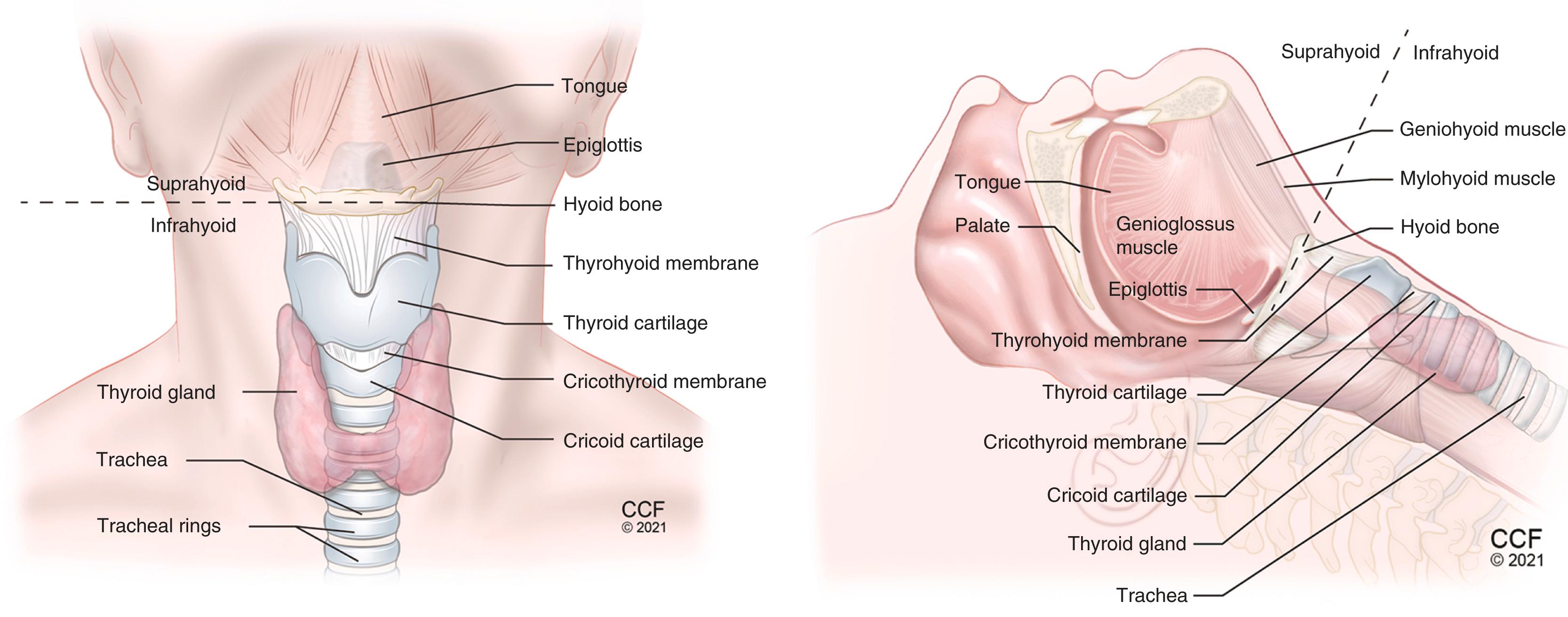
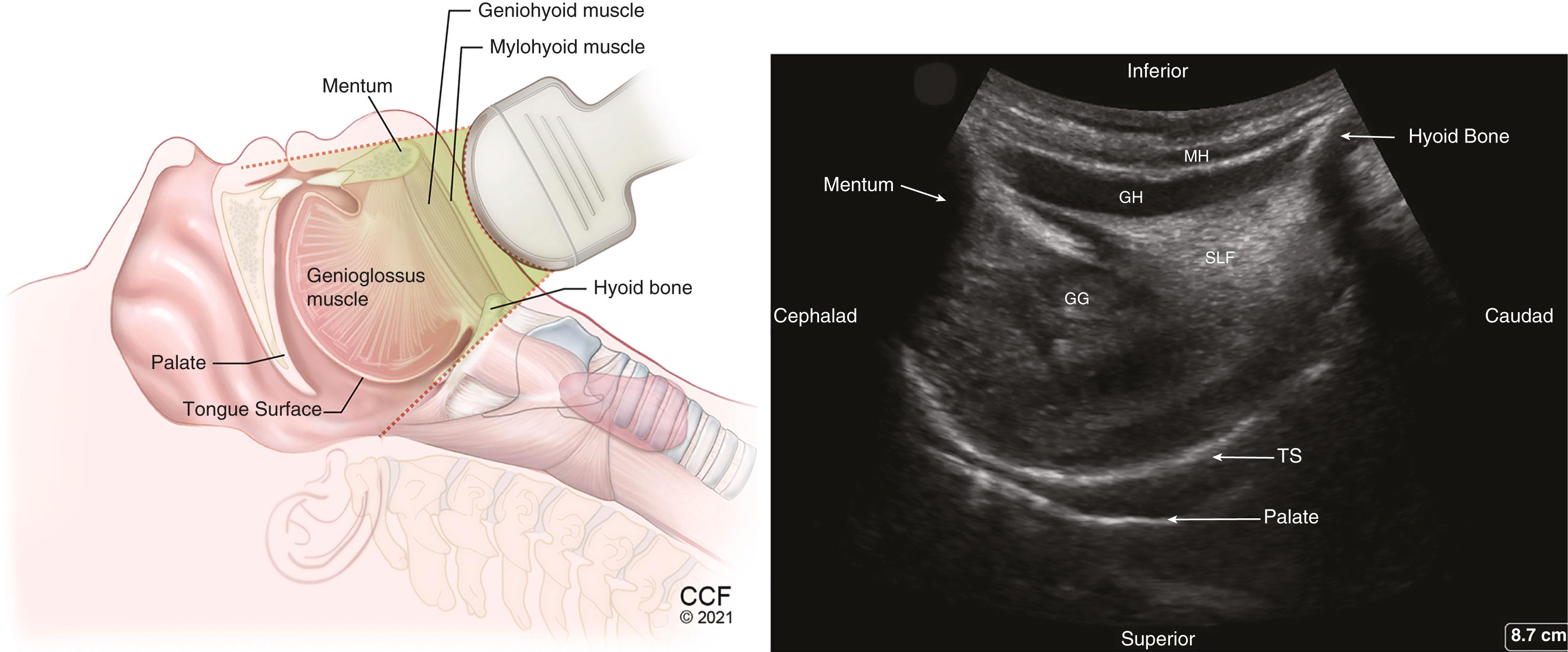
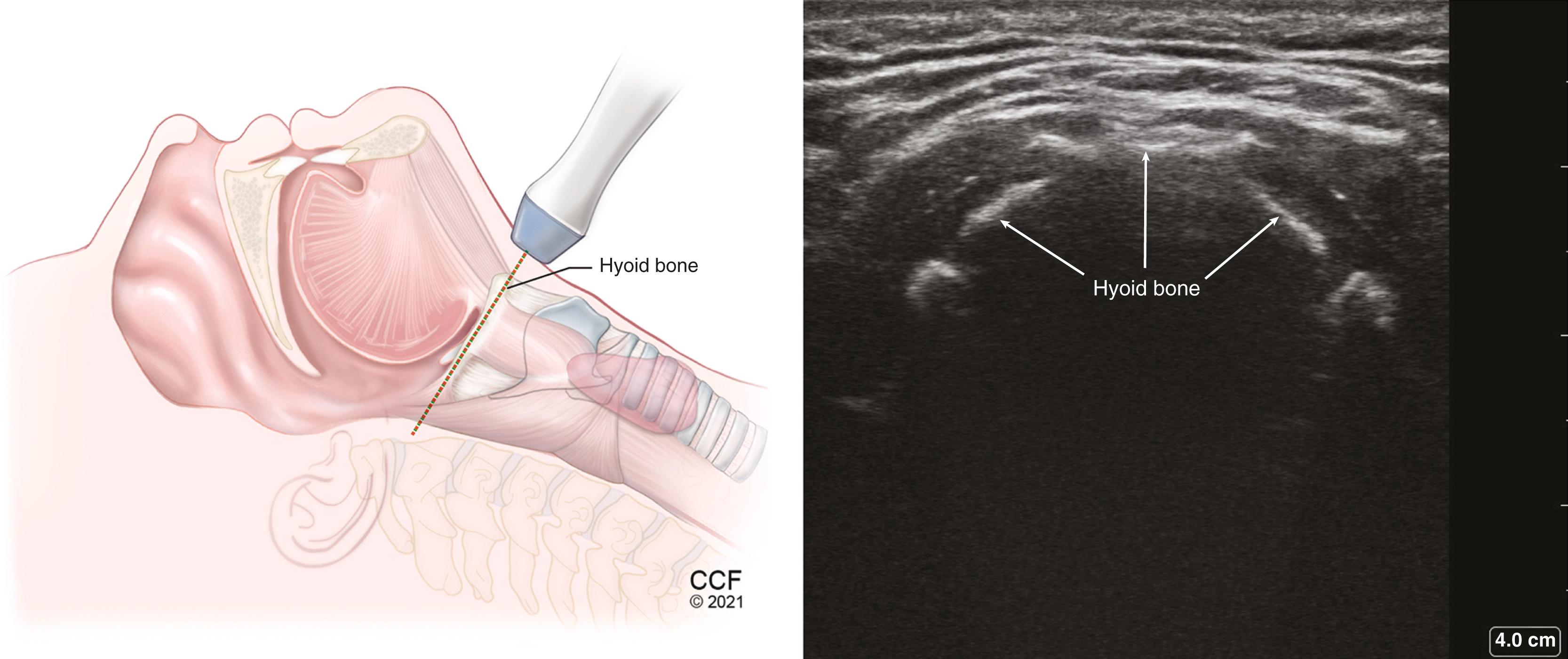
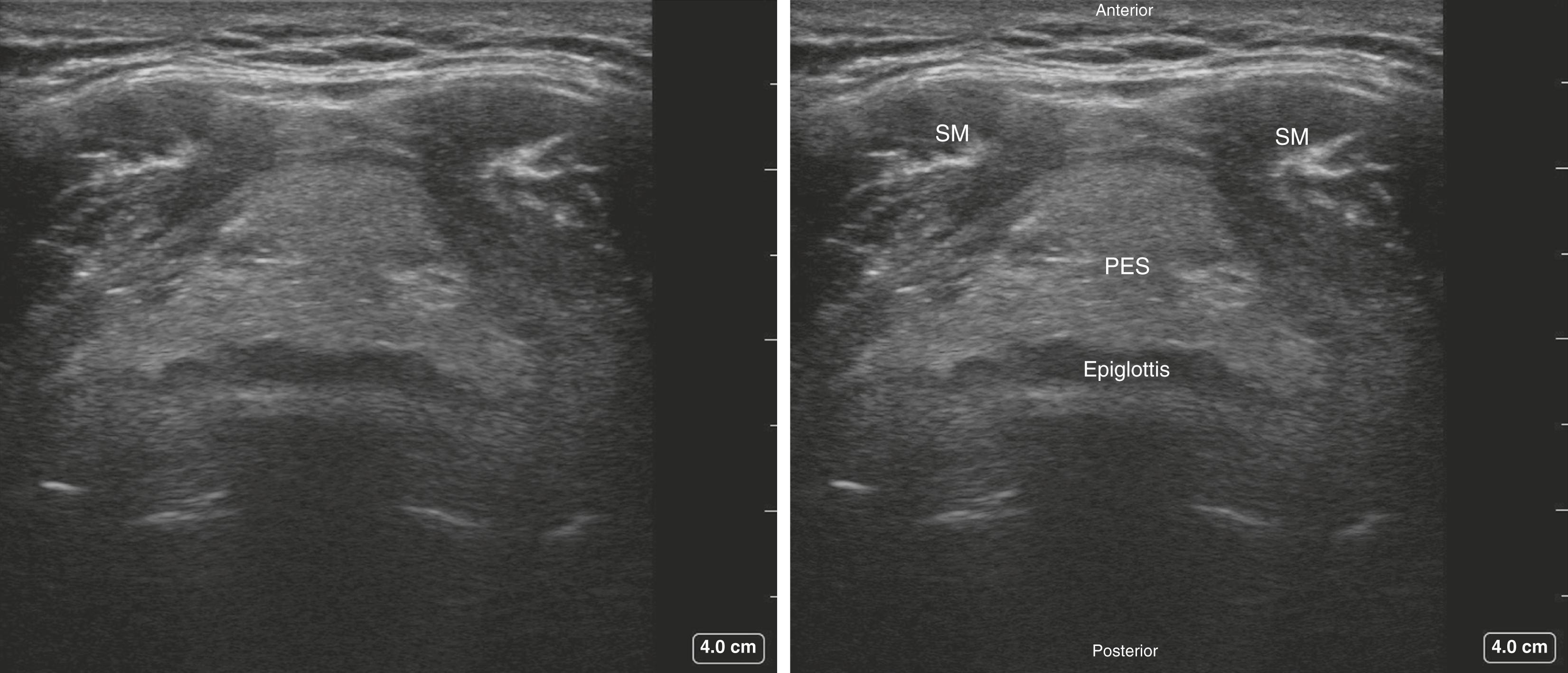

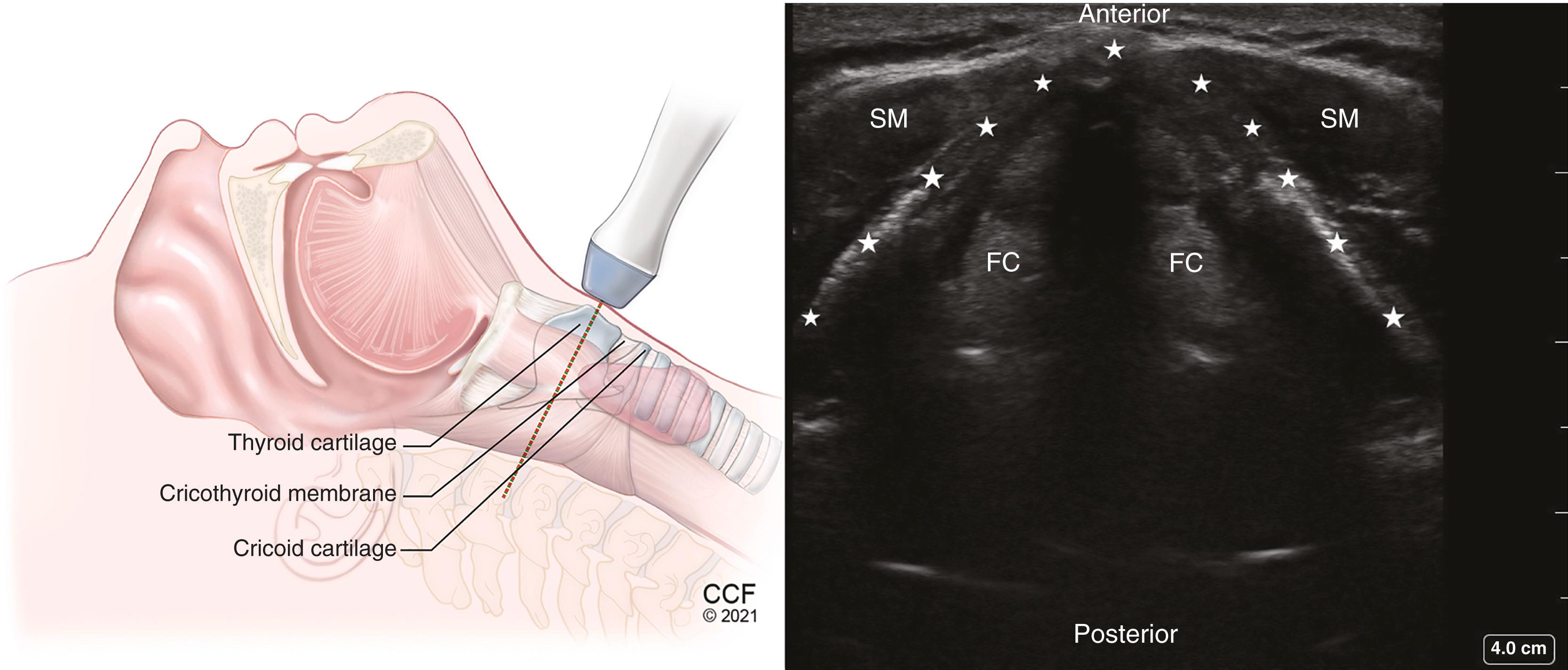
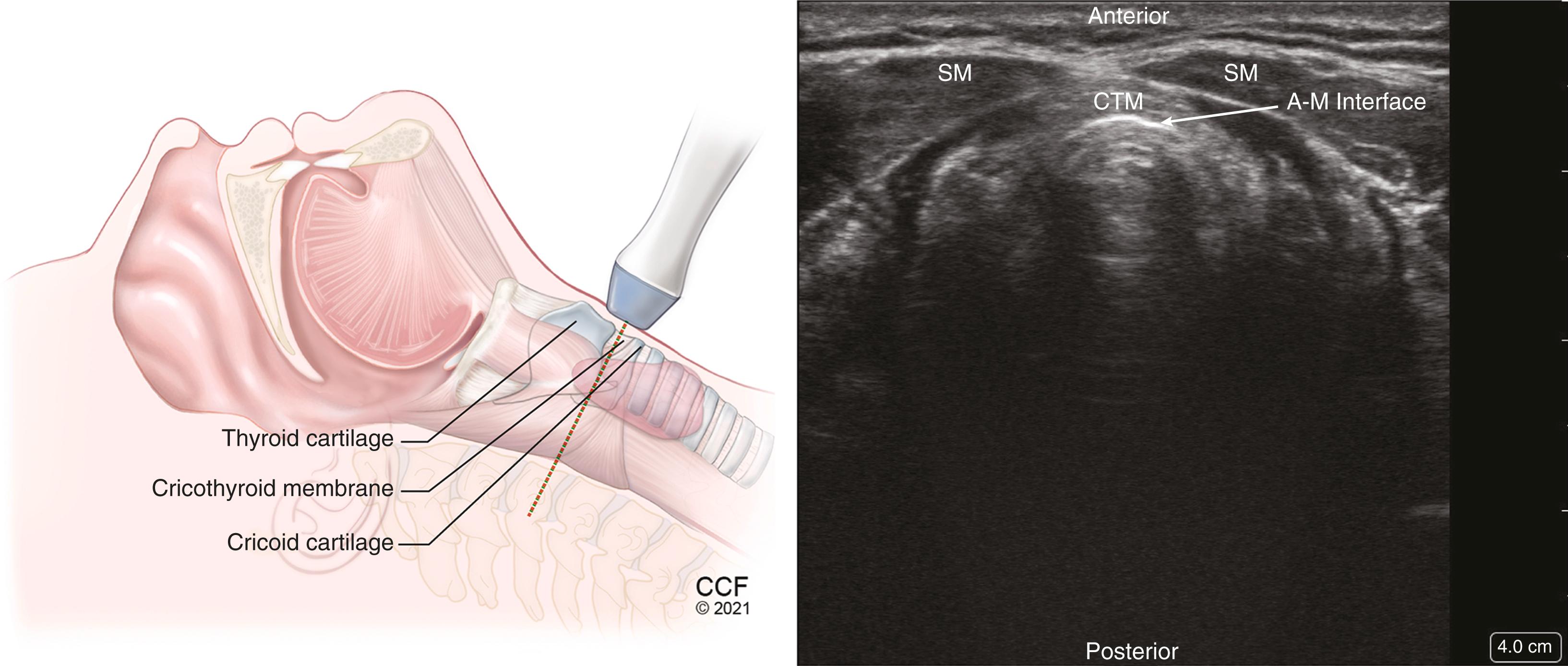
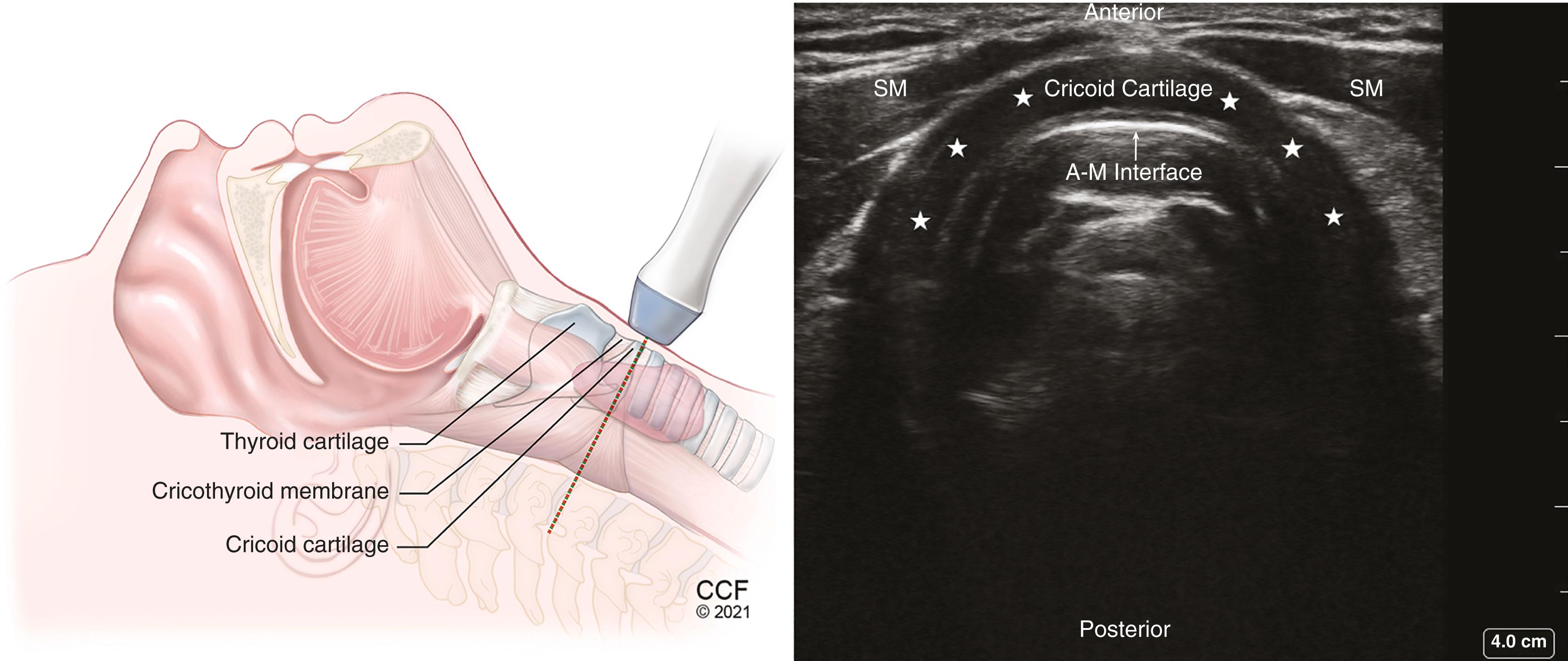
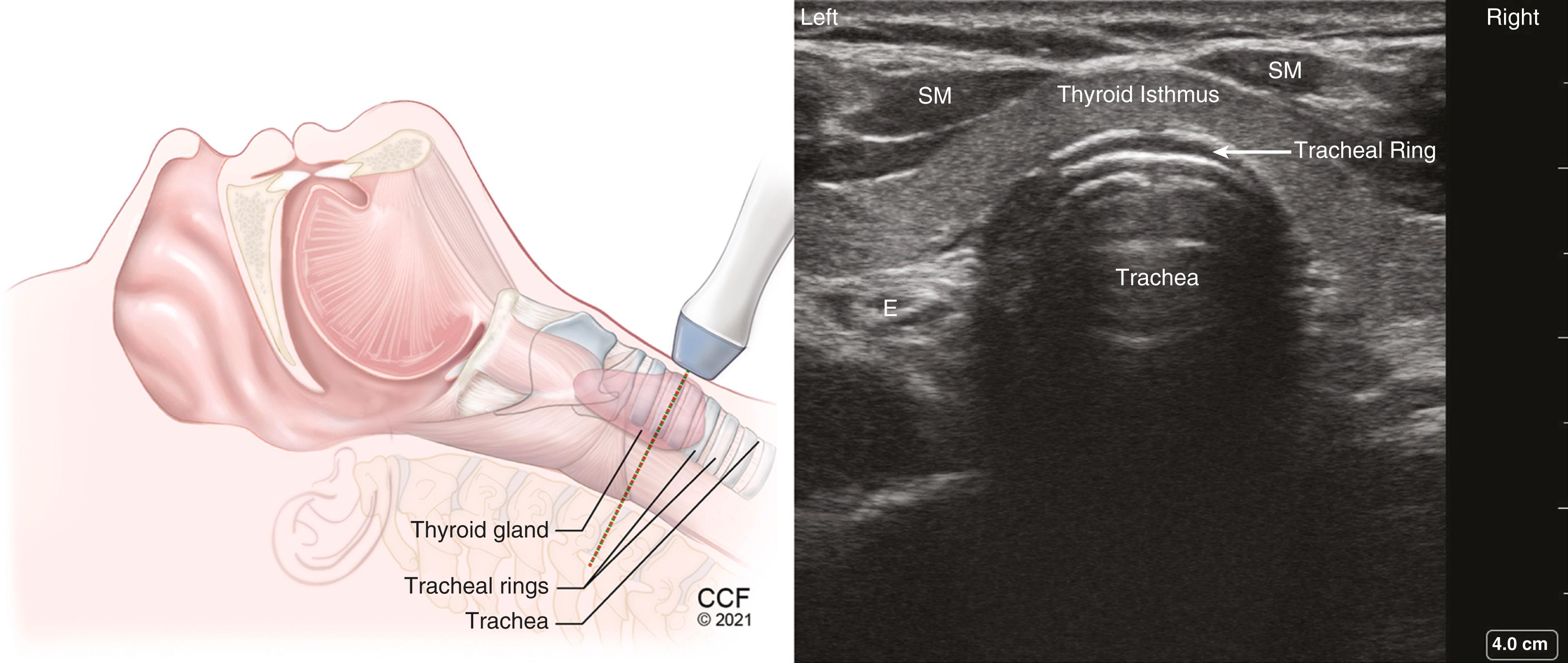

Tongue
Hyoid bone
Epiglottis
Thyrohyoid membrane
Thyroid cartilage
Cricothyroid membrane
Cricoid cartilage
Trachea
Esophagus
The cricothyroid membrane has a thick median ligament with lateral ligaments on each side. Although digital palpation may identify these structures, ultrasound guidance significantly improves the success and safety of cricothyroidotomy, especially in difficult airways. The Difficult Airway Society has recommended that airway access in the neck be performed supine with an extended neck position for best alignment of key structures ( Tables 32.2 and 32.3 ).
A high-frequency, linear transducer probe can image the hypoechoic, inverted V-shaped thyroid cartilage with the cricothyroid membrane lying caudally with the air-mucosa interface located posteriorly. The transducer can progress caudally to image the cricoid cartilage as an arch-shaped, hypoechoic structure with the hyperechoic air-mucosa interface posteriorly. After the identification of the cricoid cartilage, the transducer can move cephalad to the cricothyroid membrane to complete the imaging sequence known as the TACA (thyroid cartilage–airline–cricoid cartilage–airline) technique ( Table 32.3 ).
The cricothyroid membrane can also be identified with the transducer placed longitudinally above the suprasternal notch in the sagittal plane. The hypoechoic tracheal rings resemble a “string of pearls” lined posteriorly by a bright airway-mucosa interface. The cricoid cartilage lies cephalad as a larger and more superficial hypoechoic structure. Further cephalad is the thyroid cartilage separated from the cricoid cartilage by the cricothyroid membrane. When the cricothyroid membrane has been identified, a hyperechoic marker such as a blunt needle can mark its center in real time for performance of a cricothyroidotomy.
Awake fiberoptic intubation is a gold standard in the management of a difficult airway, including topical application of local anesthetic at specific anatomical landmarks to block the afferent neural transmission from the upper airway ( Table 32.4 ). Ultrasound-guided airway blocks may supplement airway topical anesthesia with targets including the trigeminal, glossopharyngeal, and laryngeal nerves ( Fig. 32.11 ). The superior laryngeal nerve divides into internal and external branches. The internal branch passes below the hyoid bone and enters the larynx through the thyrohyoid membrane ( Fig. 32.12 ). Ultrasound can guide the deposition of local anesthetic around the thyrohyoid membrane for a reliable block of the internal branch of superior laryngeal nerve. Transtracheal injection of local anesthetic for lower airway blockade can also be performed through the cricothyroid membrane that can reliably be identified with ultrasound imaging as described above. This block may induce coughing, as the local anesthetic can initially irritate the tracheal mucosa.
| Nerve | Areas Supplied |
|---|---|
| Trigeminal Nerve (CN V) | |
| Anterior ethmoidal nerves (V1) | Anterior nasal cavity |
| Sphenopalatine nerves (V2) | Posterior nasal cavity |
| Palatine nerves (V2) | Hard and soft palate |
| Pharyngeal branch (V2) | Roof of the nasopharynx |
| Lingual nerve (V3) | Anterior two-thirds of the tongue |
| Glossopharyngeal Nerve (CN IX) | Posterior two-thirds of the tongue, oropharynx, nasopharynx except roof, laryngopharynx, tonsils, pharyngeal surface of the epiglottis |
| Vagus Nerve (CN X) | |
| Superior laryngeal nerve | Laryngeal surface of the epiglottis and laryngeal structures above vocal cords including the superior surface of vocal folds |
| Recurrent laryngeal nerve | Inferior surface of the vocal folds, larynx below the cords and trachea |

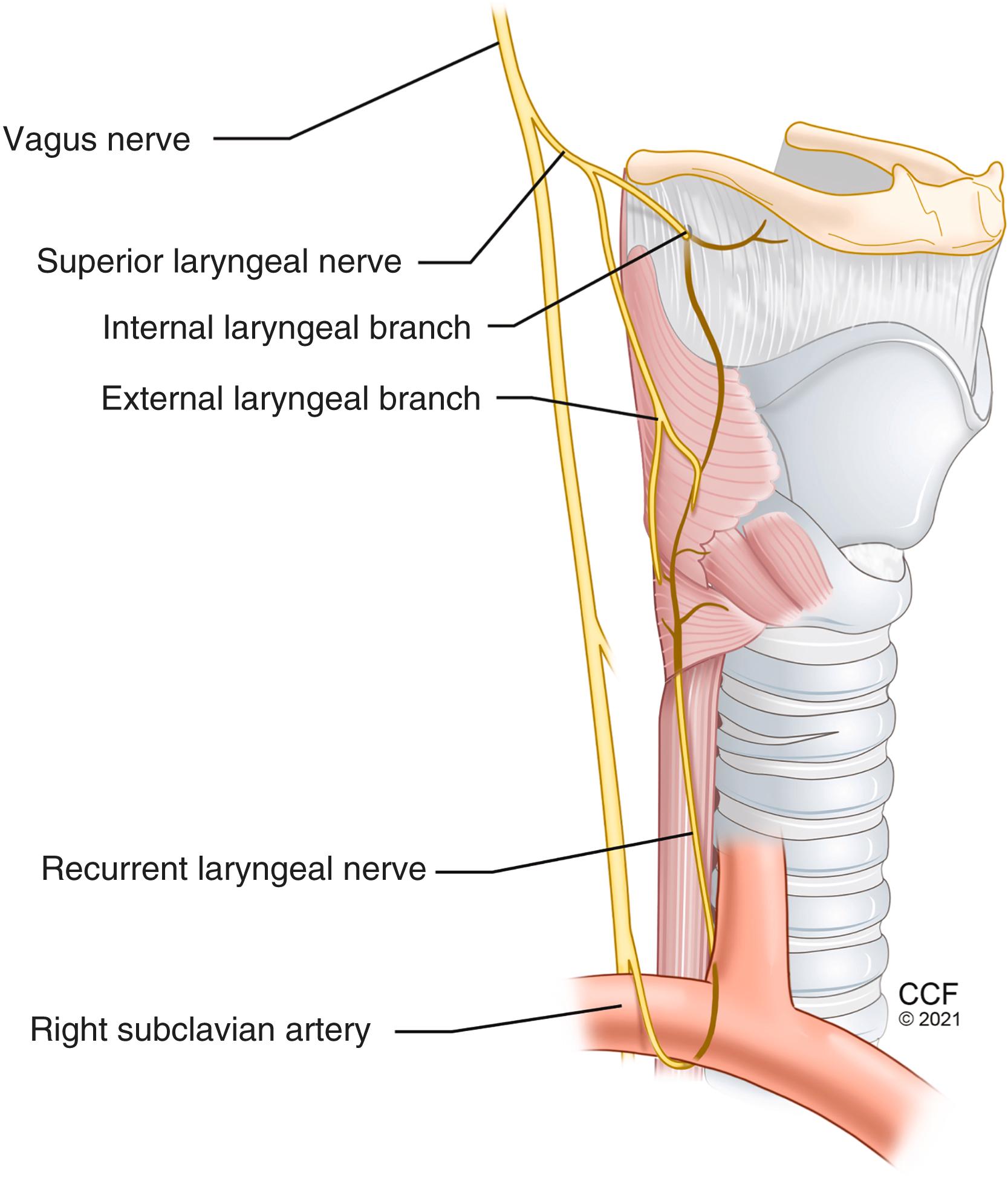
The confirmation of endotracheal tube placement with ultrasound imaging is highly accurate with a pooled sensitivity of 0.98 (95% confidence interval [CI], 0.97–0.99) and pooled specificity of 0.98 (95% CI, 0.95–0.99). A meta-analysis ( N = 1595, 17 studies) demonstrated that transtracheal ultrasonography was 98.7% sensitive (95% CI, 97.8–99.2) and 97.1% specific (95% CI, 92.4–99.0) for confirming endotracheal intubation, with a mean time to confirmation of 13 seconds (95% CI, 12.0–14.0). This accuracy is not affected by the type of endotracheal tube and/or transducer type, with a short learning curve. , Furthermore, this technique remains reliable and accurate during hemodynamic resuscitation with a low end-tidal carbon dioxide concentration.
The transducer is placed transversely in the suprasternal notch with movement in the trachea appearing like a snowstorm as the endotracheal tube crosses the imaging plane (the “snowstorm sign”). The endotracheal tube can also be visualized within the trachea (the “bullet sign”— Fig. 32.13 ). If the endotracheal tube enters the esophagus, a unique “double tract sign” is seen ( Fig. 32.14 ). Endotracheal confirmation can also be aided by maneuvers such as inflating the tube cuff with saline, looking for the lung sliding sign, and/or twisting the tube from side to side, during color flow Doppler imaging.
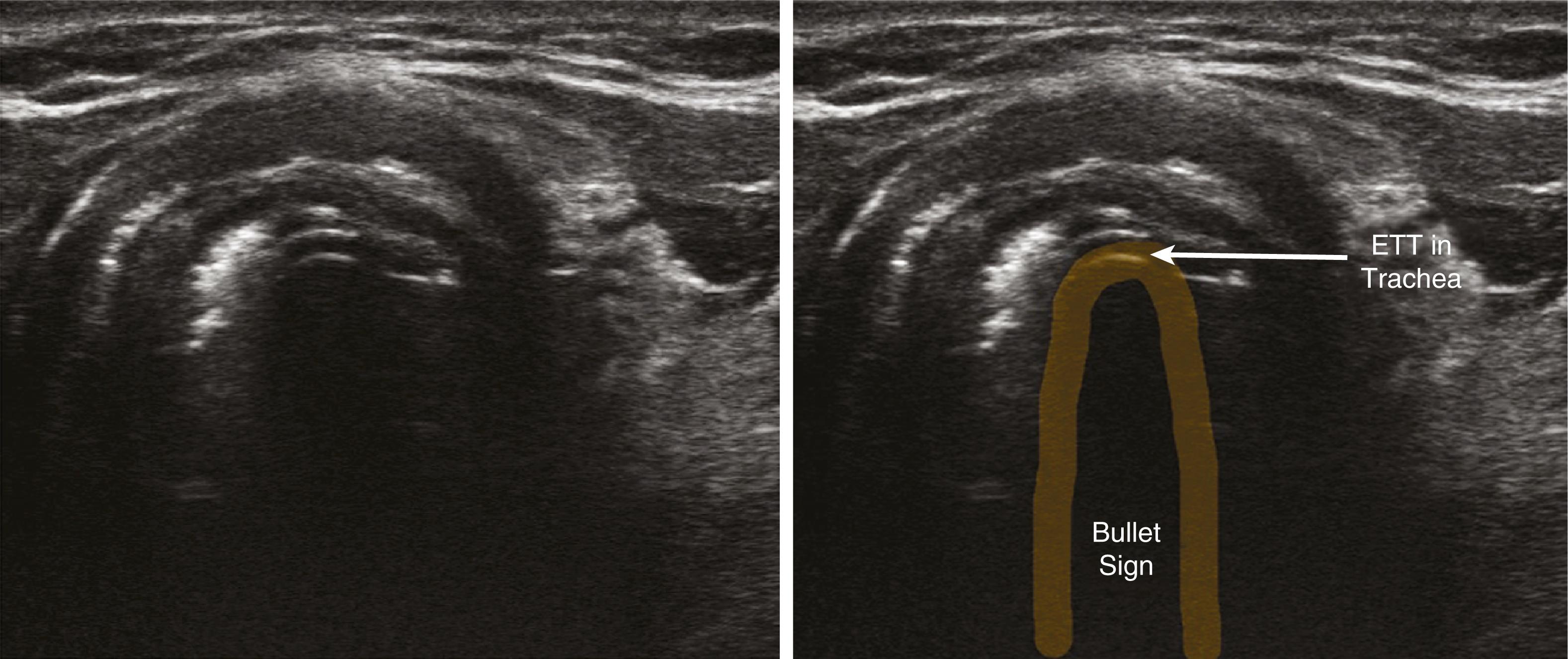
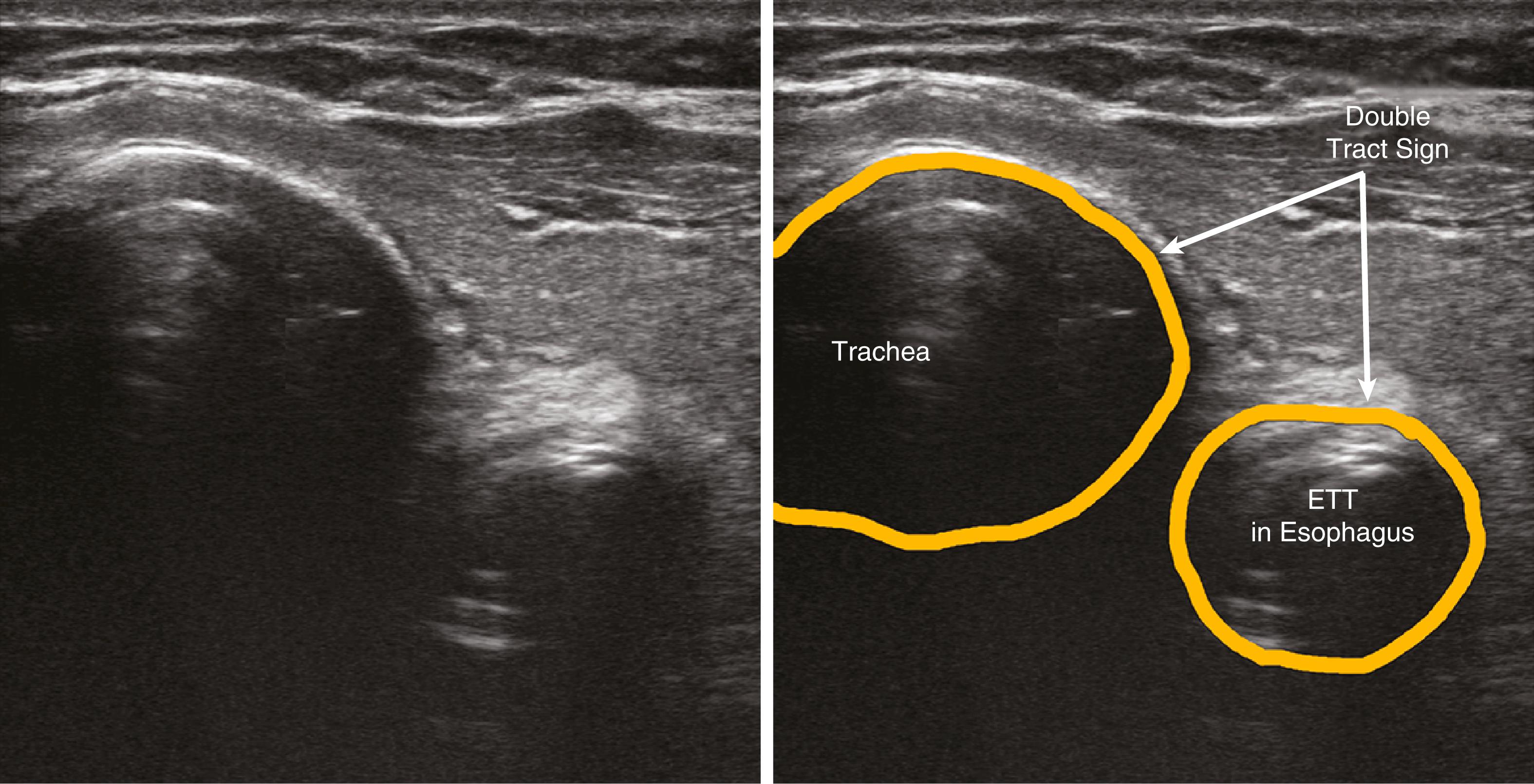
Airway ultrasound can optimize the conduct of percutaneous tracheostomy through identification of tracheal rings, local anatomy, and abnormal surrounding vasculature. Real-time ultrasound-guided percutaneous tracheostomy typically requires one operator to perform the procedure while a second operator provides ultrasound guidance. The trachea is identified by visualization of hypoechoic tracheal rings resembling a “string of pearls” lined posteriorly by a bright air-mucosa interface ( Tables 32.2 and 32.3 ). The cricoid cartilage is a larger and more superficial hypoechoic structure compared to the tracheal rings. The puncture site may be between either the first-second or second-third tracheal rings.
Airway imaging can predict for difficult mask ventilation and difficult laryngoscopy with metrics such as the skin-hyoid distance and the epiglottis-to-vocal cord space. The distance from the hyoid bone to the skin surface increases with the difficulty of mask ventilation, 1.4 cm or greater being highly predictive for difficult ventilation. A distance from the epiglottis to vocal cords >1.77 cm had an 82% sensitivity and 80% specificity for predicting difficult laryngoscopy.
Airway ultrasound can also facilitate screening for obstructive sleep apnea, evaluation of the vocal cords and epiglottis, as well as the application of cricoid pressure during rapid sequence induction. Airway ultrasound is a noninvasive, reliable, and reproducible bedside imaging technique to obtain real-time dynamic images of the upper airway anatomy. This modality has multiple applications in the critical care setting that are summarized in Box 32.3 .
Identify abnormal or difficult airways (difficult intubation and mask ventilation)
Guide procedural interventions (percutaneous cricothyroidotomy, tracheostomy)
Confirm endotracheal tube placement
Assist in performance of regional blocks for airway management
Screening for obstructive sleep apnea
Evaluation of vocal cords and epiglottis
Application of cricoid pressure during rapid sequence intubation
Lung ultrasound is integral to perioperative and critical care management of patients. It offers noninvasive, rapid, and easily repeatable diagnostic scans at the beside without the need for transfer or exposure to repeated high levels of radiation. Lung imaging with ultrasound can produce artifacts as air causes significant impedance. These easily identifiable artifacts can assist in the diagnosis of many common pathologies. This imaging modality has a rapid learning curve with multiple didactic resources to support clinical competency. , The comparative diagnostic capabilities of lung ultrasound, chest x-ray, and clinical examination for chest syndromes in contemporary intensive care practice are summarized in Table 32.5 .
| Clinical Entity | Relative Variable | Lung Ultrasound | Chest X-Ray | Clinical Examination |
|---|---|---|---|---|
| Pleural effusion | Sensitivity Specificity |
0.94 0.98 |
0.51 0.68 |
0.73 0.91 |
| Pneumothorax | Sensitivity Specificity |
0.88 1.00 |
0.52 0.99 |
0.37 0.89 |
| Interstitial injury | Sensitivity Specificity |
0.88 0.90 |
0.73 0.90 |
0.46 0.67 |
| Alveolar injury | Sensitivity Specificity |
0.94 0.96 |
0.44 0.93 |
0.33 0.90 |
| Diaphragm dysfunction | Sensitivity Specificity |
0.93 1.00 |
0.90 0.44 |
Not quantified |
Become a Clinical Tree membership for Full access and enjoy Unlimited articles
If you are a member. Log in here